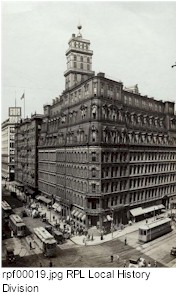
The Powers Building in 1916
Biographical Information
With two uncles already practicing architecture it seemed only natural for Andrew Jackson Warner (commonly called A.J. Warner) to become an architect. A.J. was born in Connecticut in 1833 and came to Rochester circa 1847 as an apprentice to one of his uncles, Merwin Austin. A.J. worked as a draftsman for Austin, whose commissions included the Second Monroe County Courthouse, Plymouth Congregational Church, the Josiah Bissell house and Warner’s Castle (the home of Horatio Warner). It is suspected that A.J. Warner may have had a hand in some of these designs although Austin is given full credit. In any case, A.J. must have excelled quickly in his chosen trade because he was soon made a partner in his uncle’s business.
This partnership, known as Austin & Warner, existed from about 1855 until 1858. Warner then established an independent practice until 1867 when he partnered with Charles Coots under the firm name of Andrew J. Warner & Co. In 1872 Warner again practiced independently. From 1875 until 1877 Warner had a partnership with James G. Cutler, known as Warner & Cutler. After their partnership terminated, Cutler went on to design such structures as the Elwood Building (1879) and the Kimball Tobacco Factory (c. 1880). He also designed and sold mail chutes for his Cutler Manufacturing Company before becoming mayor of the city of Rochester.
In 1877 A.J. Warner formed yet another partnership, this time with his nephew Frederick A. Brockett. The firm of Warner & Brockett was in business until 1893 when Brockett began his own practice. At this time Warner apparently went into retirement. However, city directories continue to list him as an architect with an office in the Powers Building until 1910.
Little is known about Warner’s personal life. He was active in a local chapter of the Free and Accepted Masons and he was always remembered as a hard worker. He was never involved in local politics, which is fairly surprising since he must have made numerous contacts through his business and he enjoyed such a solid reputation. Apparently A.J. Warner was content enough with his wife (Kate Foster whom he married in 1855) and family and his prosperous practice. He died in Rochester on September 4, 1910.
John Foster Warner (commonly called J. Foster Warner) was born in Rochester in 1859 and followed in his father’s footsteps. Around 1875 he began his career as a draftsman in his father’s office along with his only brother, William Amos Warner (1855-1917). Around 1883 J. Foster Warner became a partner in the firm Warner & Brockett along with his cousin and father. In 1889 J. Foster left the partnership and began a lucrative independent practice. His brother William joined his office (which had just been moved to the newly constructed Granite Building) as a clerk in 1894, around the time of their father’s retirement.
In his dapper style and his van dyke beard, J. Foster Warner was well known around Rochester. He was much more active in local social and business circles than his father had been. He was a member of the City Planning Commission and was the first chairman of the City Planning Board in 1929. He was a member of the Genesee Valley Club and was on the board of Genesee Hospital and Hillside Home for Children. J. Foster Warner was a director of the Union Trust Co. and the Stromberg-Carlson Telephone Corporation. He was also one of the original board members of the Home Telephone Company in 1899. This company merged into the Rochester Telephone Co. and J. Foster remained on the board of directors until his death.
J. Foster Warner wed Mary Adams in 1883 and they remained married for over 50 years. They had two children together: Andrew J. Warner (a local theater critic) and Major John Adams Warner (superintendent of the NY State Police). In addition to his architecture, J. Foster was probably best known for his love of cars. He was reportedly one of the first in Rochester to own an automobile. He loved to drive and he loved to race even more. Not only did he challenge other motorists on the road, but he also had a reputation for racing trains. With his death on April 9, 1937 the reign of the Warner architects ended in Rochester.
Send comments to Webmaster
Copyright 2021
Monroe County (NY) Library System
115 South Ave., Rochester, NY 14604